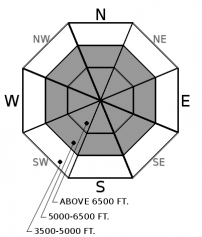| Friday | Friday Night | Saturday | |
|---|---|---|---|
| Cloud Cover: | Mostly Cloudy | Mostly Cloudy | Mostly Cloudy |
| Temperatures: | 24 to 29 deg. F. | 20 to 24 deg. F. | 24 to 30 deg. F. |
| Wind Direction: | Southwest | Southwest | Southwest |
| Wind Speed: | 16G37 | 18G43 | 24G40 |
| Snowfall: | 0 to 3" in. | 3" to 4" in. | 1" in. |
| Snow Line: | 3000' | 3000' | 2500' |
Whitefish Range
Swan Range
Flathead Range and Glacier National Park
How to read the forecast
Skiers and riders continue to trigger storm slab avalanche at mid and upper elevations. Expect to find thicker, more dangerous slabs on wind loaded terrain features, such as ridgelines and gullies further downslope. Shooting cracks, collapses, and recent avalanches are all signs to seek terrain with slope angles less than about 35 degrees.

2. Moderate
?
Above 6500 ft.
2. Moderate
?
5000-6500 ft.
1. Low
?
3500-5000 ft.
- 1. Low
- 2. Moderate
- 3. Considerable
- 4. High
- 5. Extreme
-
Type ?
-
Aspect/Elevation ?

-
Likelihood ?CertainVery LikelyLikelyPossible
 Unlikely
Unlikely -
Size ?HistoricVery LargeLargeSmall

Rider-triggered avalanches continue to trickle in from the past two days. This is bullseye information that tells us to choose terrain carefully. Today, slabs can range from 6 to 12 inches thick in sheltered locations. On wind-loaded terrain features, like ridge crests and gullies, expect to find more dangerous slabs that are upwards of 2 to 3 feet in thickness. I expect slabs to be more stubborn today, though they will be large enough to bury or injure you if triggered. Hedge your bets by sticking to terrain sheltered by the wind with slope angles less than 35 degrees.
Since Tuesday, we have seen steady snowfall and sustained winds. Snowfall totals range from 8 to 12 inches throughout the forecast area. Temperatures have slowly crept up, causing a slightly upside-down storm slab. Today, we are not looking at much snowfall; however, winds will continue to thicken slabs on leeward aspects. It is important to understand that this is not just a typical storm slab problem. In many areas, new snow has fallen on persistent weak layers just below the old snow/ new snow interface, causing more dangerous conditions.
What makes this storm slab problem troublesome depends on your location; the new snow can be sitting on surface hoar, crust facet crust combinations, or no persistent weak layers. On Wednesday, near Marias Pass, I found new snow sitting on a layer of buried surface hoar. In this area, we could trigger small avalanches and feel whumping collapses while walking a ridgeline. Yesterday, both blase and I found slabs to be cracking and failing on a crust/facet/crust combination in the southern Whitefish Range (observation 1, observation 2). We received reports of two different parties triggering avalanches in the nearby area the past two days. These were triggered on opposite aspects at mid and upper elevations. On the contrary, Mark traveled into another part of the Flathead Range and found the primary hazard to be loose dry sluffs (observation). So what can we do with this information?
When the avalanche problem becomes complicated, simplify your terrain. Seek out terrain that is sheltered from the wind and keep slope angles less than about 35 degrees. We are in a prolonged loading event, and there is uncertainty about how the snowpack will handle the extra weight, particularly crusts buried at the bottom of the snowpack. Limited data and observations from upper elevations this time of year can make forecasting these types of events challenging. It is best to embrace a conservative mindset for the next week due to this uncertainty and heavy snowfall in the forecast.
Today expect 10 to 15 mph wind speeds with gusts reaching 35 mph at the highest ridgelines. Lingering snow showers will bring a trace to three inches of snow today. Temperatures will be in the mid 20s to lower 30s at around 6000 feet. An atmospheric river is expected to impact the area by saturday evening bringing heavy snow, strong winds, and rising temperatures.
This forecast applies only to backcountry areas outside established ski area boundaries. The forecast describes general avalanche conditions and local variations always occur. This forecast expires at midnight on the posted day unless otherwise noted. The information in this forecast is provided by the USDA Forest Service who is solely responsible for its content.
















